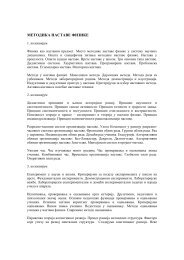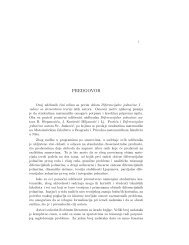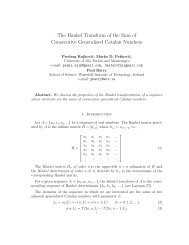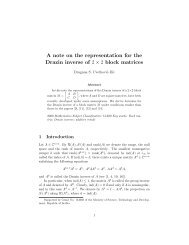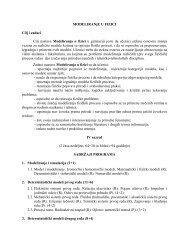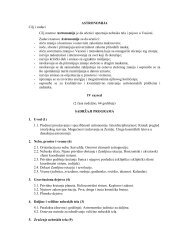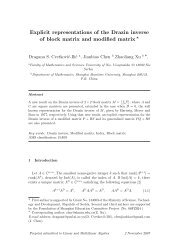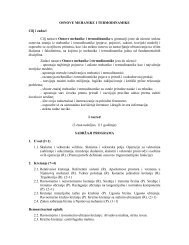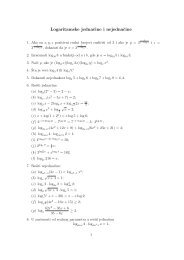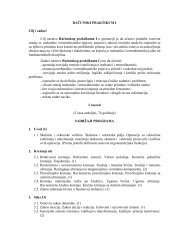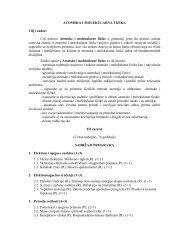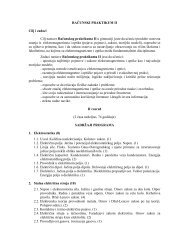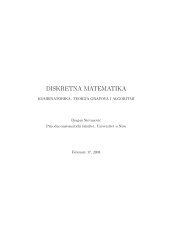On weighted reverse order laws for the Moore-Penrose inverse and ...
On weighted reverse order laws for the Moore-Penrose inverse and ...
On weighted reverse order laws for the Moore-Penrose inverse and ...
Create successful ePaper yourself
Turn your PDF publications into a flip-book with our unique Google optimized e-Paper software.
E. Boasso, D. S. Cvetković-Ilić, R. Harte 10<br />
Theorem 3.8. Let R be a ring with involution. Consider a, b ∈ R † such that ab, a(e − bb † ) ∈<br />
R † . Let c ∈ R such that c commutes with a <strong>and</strong> a ∗ , cab = ab <strong>and</strong> c ∗ ab = ab. Then, <strong>the</strong><br />
following statements are equivalent:<br />
(i) bb † a ∗ ab = a ∗ ab;<br />
(ii) b{1, 3} · a{1, 3} · c ⊆ (ab){1, 3};<br />
(iii) b † a † c ∈ (ab){1, 3};<br />
(iv) b † a † c ∈ (ab){1, 2, 3}.<br />
Proof. Under <strong>the</strong> conditions of <strong>the</strong> <strong>the</strong>orem, using <strong>the</strong> matrix representations given in Remark<br />
3.1, it is not difficult to prove that b † a † c = b † a † <strong>and</strong> that necessary <strong>and</strong> sufficient condition<br />
<strong>for</strong> (ii) to holds is <strong>the</strong> fact that b{1, 3}·a{1, 3} ⊆ (ab){1, 3}. The proof follows by [3, Theorem<br />
3.1]. Note that <strong>the</strong> proof of [3, Theorem 3.1] holds under <strong>the</strong> conditions of <strong>the</strong> <strong>the</strong>orem.<br />
Theorem 3.9. Let R be a ring with involution. Consider a, b ∈ R † such that ab, (e−a † a)b ∈<br />
R † . Let c ∈ R such that c commutes with b <strong>and</strong> b ∗ , abc = ab <strong>and</strong> abc ∗ = ab. Then, <strong>the</strong><br />
following statements are equivalent:<br />
(i) abb ∗ a † a = abb ∗ ;<br />
(ii) c · b{1, 4} · a{1, 4} ⊆ (ab){1, 4};<br />
(iii) cb † a † ∈ (ab){1, 4};<br />
(iv) cb † a † ∈ (ab){1, 2, 4}.<br />
Proof. Apply Theorem 3.4 to b ∗ <strong>and</strong> a ∗ using that x ∗ {1, 3} = (x{1, 4}) ∗ <strong>and</strong> x ∗ {1, 2, 3} =<br />
(x{1, 2, 4}) ∗ , x ∈ R.<br />
References<br />
[1] J. K. Baksalary, O. M. Baksalary, An invariance property related to <strong>the</strong> <strong>reverse</strong> <strong>order</strong><br />
law, Linear Algebra Appl. 410 (2005), 64–69.<br />
[2] E. Boasso, <strong>On</strong> <strong>the</strong> <strong>Moore</strong>-<strong>Penrose</strong> <strong>inverse</strong> in C ∗ -algebras, Extracta Math. 21 (2) (2006),<br />
93-106.<br />
[3] D. S. Cvetković-Ilić, R. E. Harte, Reverse <strong>order</strong> <strong>laws</strong> in C*-algebras, submitted.<br />
[4] T. N. E. Greville, Note on <strong>the</strong> generalized <strong>inverse</strong> of a matrix product, SIAM Rev. 8 (4)<br />
(1966), 518-521. Erratum, ibid 9 (2) (1967), 249.<br />
[5] R. E. Harte, M. Mbekhta, <strong>On</strong> generalized <strong>inverse</strong>s in C ∗ -algebras, Studia Math. 103<br />
(1992), 71-77.<br />
[6] J. J. Koliha, P. Patrício, Elements of rings with equal spectral idempotents, J. Aust.<br />
Math. Soc. 72 (2002), 137-152.<br />
[7] J. J. Koliha, D. Djordjevic, D. Cvetkovic, <strong>Moore</strong>-<strong>Penrose</strong> <strong>inverse</strong> in rings with involution,<br />
Linear Algebra Appl. 426 (2007), 371-381.



